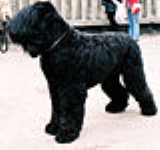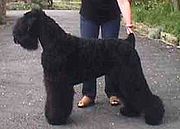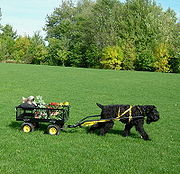
Black Russian Terrier
Encyclopedia
The Black Russian Terrier , abbreviated as BRT, or Stalin's dog (Sobaka Stalina) is a breed
of dog
, developed to serve as guard dog
and police dog
. It is rare outside the countries of the former Soviet Union but beginning to be formally recognized elsewhere: in July 2004, for instance, it became one of the AKC's
recognized breeds.
Despite its name, the Black Russian Terrier is not a true terrier: it is believed that about twenty breeds were used in its development, including the Airedale, the Giant Schnauzer, the Rottweiler, the Newfoundland, the Caucasian Ovtcharka and the now extinct Moscow Water Dog.
 The Black Russian Terrier gives the impression of great strength, athleticism, and courage. It should be rustic (but not coarse) in appearance, and should not look as though its coat is sculpted or trimmed. It should never appear to lack substance or be weak in any way. Males should be noticeably more masculine than females.
The Black Russian Terrier gives the impression of great strength, athleticism, and courage. It should be rustic (but not coarse) in appearance, and should not look as though its coat is sculpted or trimmed. It should never appear to lack substance or be weak in any way. Males should be noticeably more masculine than females.

is a must, as it will exploit any owner who has failed to establish clear dominance. They are very responsive to firm, consistent training, and excel at Obedience
competitions. They also perform well in other dog sports, such as Agility
, and Schutzhund
training. They have a low-shedding coat, and need grooming several times a week. Dogs who compete in conformation need to be groomed a minimum of every three weeks to keep the coat in show condition. The Black Russian Terrier needs lots of exercise, and may become hyperactive and destructive if it does not have a chance to burn off its energy.
:
Major concerns
Minor concerns
This is why it is extremely important to screen any potential breeders as well as their breeding stock. A well intended breeder will have all health checks on all breeding stock before making the decision to breed their dogs. While health checks on breeding stock can not guarantee a puppy will not develop any health issues later on, it is important to "do your homework" on any potential breeder.
by the state for use as a military/working dogs. The breeding stock was largely imported from the occupied countries, especially East Germany. Breeds used in the development include the Airedale Terrier
, Caucasian Ovcharka
, Newfoundland
, Giant
and Standard Schnauzer
s and the now extinct Moscow Water Dog
. BRT were bred for working ability, rather than appearance, and early examples only resembled today's Black Russian Terrier in their build and coat type. The BRT was bred solely by the state owned Red Star Kennel until 1957, when some puppies were sold to civilian breeders. These breeders began to breed for looks (as the original was rather plain) while retaining working ability. In time, the breed spread to the Balkans
, Ukraine
, and Siberia
, and later to Finland
, Hungary
, Czechoslovakia
, and the United States
.
The breed was recognized by the FCI
[Federation Cynologique Internationale ] in 1984. On July 1, 2004, it was recognized by the American Kennel Club
[AKC] in the Working Group. The Canadian Kennel Club has the Black Russian Terrier as a "listed" (formally Miscellaneous Class) breed in the Working Group.
Dog breed
Dog breeds are groups of closely related and visibly similar domestic dogs, which are all of the subspecies Canis lupus familiaris, having characteristic traits that are selected and maintained by humans, bred from a known foundation stock....
of dog
Dog
The domestic dog is a domesticated form of the gray wolf, a member of the Canidae family of the order Carnivora. The term is used for both feral and pet varieties. The dog may have been the first animal to be domesticated, and has been the most widely kept working, hunting, and companion animal in...
, developed to serve as guard dog
Guard dog
A guard dog, an attack dog or watch dog is a dog used to guard against, and watch for, unwanted or unexpected people or animals. The dog is discriminating so that it does not annoy or attack familiar people.-Barking:...
and police dog
Police dog
A police dog, often referred to as a "K-9 dog" in some areas , is a dog that is trained specifically to assist police and other law-enforcement personnel in their work...
. It is rare outside the countries of the former Soviet Union but beginning to be formally recognized elsewhere: in July 2004, for instance, it became one of the AKC's
American Kennel Club
The American Kennel Club is a registry of purebred dog pedigrees in the United States. Beyond maintaining its pedigree registry, this kennel club also promotes and sanctions events for purebred dogs, including the Westminster Kennel Club Dog Show, an annual event which predates the official...
recognized breeds.
Despite its name, the Black Russian Terrier is not a true terrier: it is believed that about twenty breeds were used in its development, including the Airedale, the Giant Schnauzer, the Rottweiler, the Newfoundland, the Caucasian Ovtcharka and the now extinct Moscow Water Dog.
Appearance

Coat
The coat is a double coat with a coarse outer guard hair over a softer undercoat. The coat is hard and dense, never soft, woolly, silky or frizzy. It should be between 5 to 15 cm (2-6 inches) [Standard #327, FCI, 2010] in length. It should form a beard and eyebrows on the face, and a slight mane around the withers and neck that is more pronounced in males. The coat is low-shedding and the colour is black with some gray hairs.Size
According to the FCI standard the male stands 72 to 76 cm and not more than 78 cm at the withers compared to the female’s 68–72 cm and not more than 74 cm. The male weighs between 50 and 60 kg (110-132 lbs), and the females weigh between 45 and 50 kg (99-110 lbs). Nowadays, even larger individuals are tolerated if the dog is well proportioned and retains correct movements. At maturity (over 18 months of age), the AKC standard recommends 27-30 inches for males with the desired height between 27 and 29 inches and 26 and 29 inches for females with the desired height between 26 and 28 inches. A mature male less than 27 inches or more than 30 inches at the withers is considered a serious fault. A mature female less than 26 inches or more than 29 inches at the withers is considered a serious fault. In proportions, a Black Russian Terrier should be slightly longer than tall, 9 ½ to 10 being ideal.Temperament
Black Russian Terriers are confident, calm, highly intelligent, brave and loyal. It should never be timid. The Black Russian Terrier may seem aloof, but needs human companionship and bonds deeply to its family.
Care
The Black Russian Terrier, because of its breeding as a working dog, has a very strong "work ethic", and needs a job to do in order to be happy. Early trainingis a must, as it will exploit any owner who has failed to establish clear dominance. They are very responsive to firm, consistent training, and excel at Obedience
Obedience trial
An obedience trial is a dog sport in which a dog must perfectly execute a predefined set of tasks when directed to do so by his handler. According the American Kennel Club obedience regulations...
competitions. They also perform well in other dog sports, such as Agility
Dog agility
Dog agility is a dog sport in which a handler directs a dog through an obstacle course in a race for both time and accuracy. Dogs run off-leash with no food or toys as incentives, and the handler can touch neither dog nor obstacles...
, and Schutzhund
Schutzhund
Schutzhund is a dog sport that was developed in Germany in the early 1900s as a breed suitability test for the German Shepherd Dog. The test would determine if the dog displayed the appropriate traits and characteristics of a proper working German Shepherd Dog...
training. They have a low-shedding coat, and need grooming several times a week. Dogs who compete in conformation need to be groomed a minimum of every three weeks to keep the coat in show condition. The Black Russian Terrier needs lots of exercise, and may become hyperactive and destructive if it does not have a chance to burn off its energy.
Health
The Black Russian Terrier is a generally healthy and somewhat long-lived dog (lifespan of 10–14 years), however it is prone to certain hereditary diseasesGenetic disorder
A genetic disorder is an illness caused by abnormalities in genes or chromosomes, especially a condition that is present from before birth. Most genetic disorders are quite rare and affect one person in every several thousands or millions....
:
Major concerns
- Hip dysplasia
- Elbow dysplasiaElbow dysplasiaElbow dysplasia is a condition involving multiple developmental abnormalities of the elbow-joint in the dog, specifically the growth of cartilage or the structures surrounding it. These abnormalities, known as 'primary lesions', give rise to osteoarthritic processes...
Minor concerns
- HyperuricosuriaHyperuricosuriaHyperuricosuria is a medical term referring to the presence of excessive amounts of uric acid in the urine. Notable direct causes of hyperuricosuria are dissolution of uric acid crystals in the kidneys or urinary bladder, and hyperuricemia...
- Progressive retinal atrophyProgressive retinal atrophyProgressive retinal atrophy is a group of genetic diseases seen in certain breeds of dogs and, more rarely, cats. Similar to retinitis pigmentosa in humans, it is characterized by the bilateral degeneration of the retina, causing progressive vision loss culminating in blindness...
(PRA)
This is why it is extremely important to screen any potential breeders as well as their breeding stock. A well intended breeder will have all health checks on all breeding stock before making the decision to breed their dogs. While health checks on breeding stock can not guarantee a puppy will not develop any health issues later on, it is important to "do your homework" on any potential breeder.
History
The Black Russian Terrier was developed in the former USSRSoviet Union
The Soviet Union , officially the Union of Soviet Socialist Republics , was a constitutionally socialist state that existed in Eurasia between 1922 and 1991....
by the state for use as a military/working dogs. The breeding stock was largely imported from the occupied countries, especially East Germany. Breeds used in the development include the Airedale Terrier
Airedale Terrier
The Airedale Terrier is a breed of the terrier type that originated in Airedale, a geographic area in Yorkshire, England. It is traditionally called the "King of Terriers" because it is the largest of the terrier breeds...
, Caucasian Ovcharka
Caucasian Ovcharka
- External links :* *...
, Newfoundland
Newfoundland (dog)
The Newfoundland is a breed of large dog. Newfoundlands can be black, brown, gray, or black and white. They were originally bred and used as a working dog for fishermen in the Dominion of Newfoundland, now part of Canada. They are known for their giant size, tremendous strength, calm dispositions,...
, Giant
Giant Schnauzer
The Giant Schnauzer is a large, powerful, and compact breed of dog. It is one of the three Schnauzer breeds. Like most large breeds, the Giant Schnauzer needs a fair amount of exercise.-Appearance:...
and Standard Schnauzer
Standard Schnauzer
The Standard Schnauzer is the original breed of the three breeds of Schnauzer, and despite its wiry coat and general appearance, is not related to the British terriers. Rather, its origins are in old herding and guard breeds of Europe. Generally classified as a working or utility dog, this...
s and the now extinct Moscow Water Dog
Moscow Water Dog
The Moscow Water Dog, also known as the Moscow Diver, Moscow Retriever or Moskovsky Vodolaz, is a little-known dog breed derived from the Newfoundland, Caucasian Ovcharka and East European Shepherd. It is now extinct, but was used in the development of the Russian Black Terrier...
. BRT were bred for working ability, rather than appearance, and early examples only resembled today's Black Russian Terrier in their build and coat type. The BRT was bred solely by the state owned Red Star Kennel until 1957, when some puppies were sold to civilian breeders. These breeders began to breed for looks (as the original was rather plain) while retaining working ability. In time, the breed spread to the Balkans
Balkans
The Balkans is a geopolitical and cultural region of southeastern Europe...
, Ukraine
Ukraine
Ukraine is a country in Eastern Europe. It has an area of 603,628 km², making it the second largest contiguous country on the European continent, after Russia...
, and Siberia
Siberia
Siberia is an extensive region constituting almost all of Northern Asia. Comprising the central and eastern portion of the Russian Federation, it was part of the Soviet Union from its beginning, as its predecessor states, the Tsardom of Russia and the Russian Empire, conquered it during the 16th...
, and later to Finland
Finland
Finland , officially the Republic of Finland, is a Nordic country situated in the Fennoscandian region of Northern Europe. It is bordered by Sweden in the west, Norway in the north and Russia in the east, while Estonia lies to its south across the Gulf of Finland.Around 5.4 million people reside...
, Hungary
Hungary
Hungary , officially the Republic of Hungary , is a landlocked country in Central Europe. It is situated in the Carpathian Basin and is bordered by Slovakia to the north, Ukraine and Romania to the east, Serbia and Croatia to the south, Slovenia to the southwest and Austria to the west. The...
, Czechoslovakia
Czechoslovakia
Czechoslovakia or Czecho-Slovakia was a sovereign state in Central Europe which existed from October 1918, when it declared its independence from the Austro-Hungarian Empire, until 1992...
, and the United States
United States
The United States of America is a federal constitutional republic comprising fifty states and a federal district...
.
The breed was recognized by the FCI
Fédération Cynologique Internationale
Fédération Cynologique Internationale is an international federation of kennel clubs based in Thuin, Belgium. The English language translation, World Canine Organisation, is not often used.Its goals are described in Article 2 of their regulations:...
[Federation Cynologique Internationale ] in 1984. On July 1, 2004, it was recognized by the American Kennel Club
American Kennel Club
The American Kennel Club is a registry of purebred dog pedigrees in the United States. Beyond maintaining its pedigree registry, this kennel club also promotes and sanctions events for purebred dogs, including the Westminster Kennel Club Dog Show, an annual event which predates the official...
[AKC] in the Working Group. The Canadian Kennel Club has the Black Russian Terrier as a "listed" (formally Miscellaneous Class) breed in the Working Group.
External links
- Black Russian Terrier Club of America
- Russian Black Terrier Club
- Black Russian Terrier Breed Database
- Black Russian Terrier - Database
- American Kennel Club - Black Russian Terrier Breed Standard
- FCI Standard No. 327
- Canine Hyperuricosuria
- Information in Spanish
- Links to information in different languages
- Links to additional information
- FCI Standard #327 Effective 13 October 2010. http://www.fci.be/uploaded_files/327g02-en.doc
- AKC Standard for Black Russian Terriers Effective 1 July 2009. http://www.akc.org/breeds/black_russian_terrier/
- Canine Hyperuricurosia http://www.vgl.ucdavis.edu/services/Hyperuricosuria.php
- Black Russian Terriers in Missouri, USA https://sites.google.com/site/blackrussianterrierusa/

